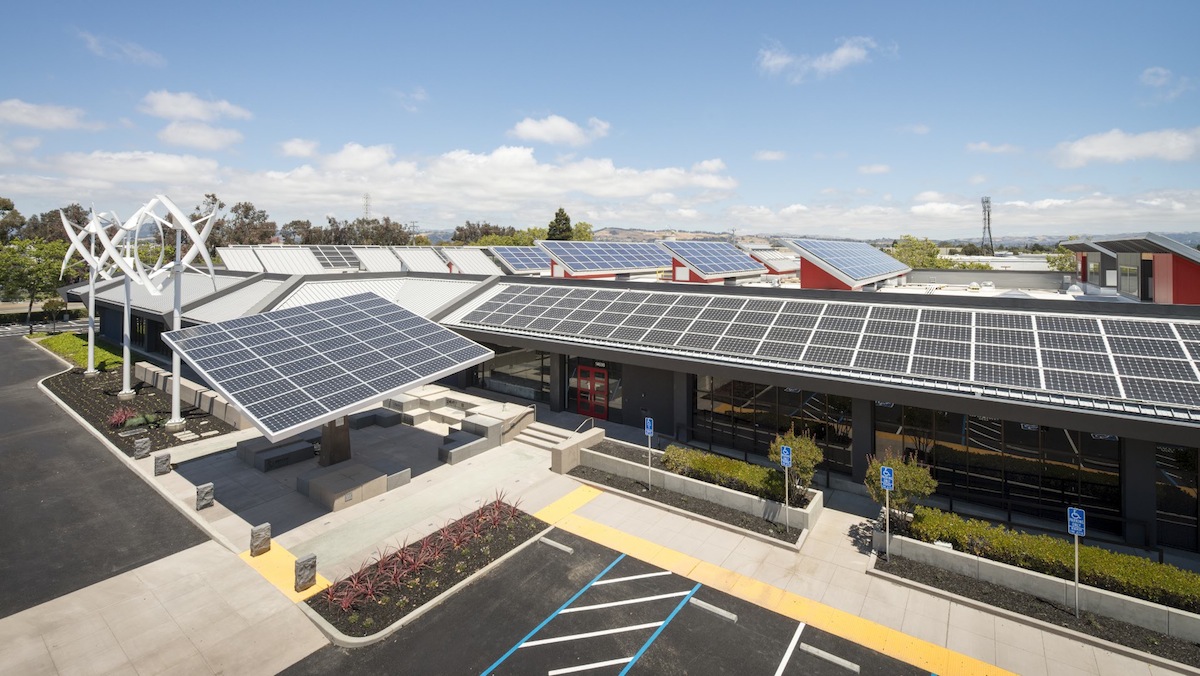Construction has begun Los Angeles County on what is being called the nation’s largest Net Zero Plus retrofit of a commercial building.
The transformation of the 142,000-sf Electrical Training Center—which was formally announced 11 months ago—should be completed by Spring 2016. (Its grand opening is scheduled for April 21—Earth Day of that year.)
It will be renamed the Net Zero Plus Electrical Training Institute, and the building will demonstrate the future of smart energy efficiency, microgrid system integration, energy storage solutions, resiliency in the wake of a natural disaster or grid interruption, and advanced lighting controls and automated building management systems.
The International Brotherhood of Electrical Workers Local 11, with more than 13,000 members; and the Los Angeles Chapter of the National Electrical Contractors Association, which represents more than 400 electrical contractors in Los Angeles and Ventura Counties, are investing $13 million into this retrofit. The General Contractor on this project is Santa Fe Springs, Calif.-based PDE Total Energy Solutions, and the Electrical Contractor is Chatsworth, Calif.-based O’Bryant Electric.
California’s latest construction codes call for all new commercial buildings to be built to net zero standards by 2030. To that end, the union and association have also launched their Net Zero Plus initiative to accelerate the shift toward a clean-energy economy. This initiative is intended to help the building industry improve grid reliability, implement energy storage solutions, as well as advance energy independence, security, and building control. The initiative also aims at reducing the environmental impacts of commercial buildings, reduce electricity costs, and provide better analytics.
The Training Center instructs over 4,000 apprentices and journeymen electricians annually. The retrofitted facility “will set the standard for training as a replicable model for other electrical training centers around the country,” said Marvin Kropke, the Local’s business manager.
Den Henrich, president of PDE Total Energy Solutions, estimates that the retrofit would reduce the building’s energy consumption by between 15% and 30%. The retrofit will include the installation of one megawatt of solar photovoltaic panels, with two arrays on the roof and two solar shade systems with a charging station in the parking lot.
The energy usage reduction is projected to be 250,000 kWh per year, and the building will have the capacity to produce about one megawatt of energy. The building is also expected to achieve a 28.5-ton annual reduction in CO2 emissions.
The training center is working with the Los Angeles Department of Water and Power to develop, test, and implement strategies that lead to the adoption of energy efficient technologies with the utility’s customers, said David Jadot, PE, LADWP’s director.
Related Stories
Sustainability | Jul 27, 2023
USGBC warns against building energy code preemptions, rollbacks
In a recent editorial, the USGBC cited a growing number of U.S. state legislators who are “aiming to roll back building energy code standards and/or preempt local governments from advancing energy-efficient building codes.”
Resiliency | Jul 27, 2023
'Underground climate change' can damage building foundations, civil infrastructure
A phenomenon known as “underground climate change” can lead to damage of building foundations and civil infrastructure, according to a researcher at Northwestern University. When the ground gets hotter, it can expand and contract, causing foundations to move and sometimes crack.
Sustainability | Jul 19, 2023
California lawmakers approve governor’s plan to accelerate green construction
California lawmakers recently approved Gov. Gavin Newsom’s infrastructure streamlining plan that aims to accelerate clean energy and infrastructure projects.
Sustainability | Jul 13, 2023
Deep green retrofits: Updating old buildings to new sustainability standards
HOK’s David Weatherhead and Atenor’s Eoin Conroy discuss the challenges and opportunities of refurbishing old buildings to meet modern-day sustainability standards.
Mass Timber | Jul 11, 2023
5 solutions to acoustic issues in mass timber buildings
For all its advantages, mass timber also has a less-heralded quality: its acoustic challenges. Exposed wood ceilings and floors have led to issues with excessive noise. Mass timber experts offer practical solutions to the top five acoustic issues in mass timber buildings.
Codes | Jul 10, 2023
Water Demand Calculator outperforms traditional plumbing codes for energy, carbon, and water savings
Using IAPMO’s Water Demand Calculator tool can result in energy, carbon, and water savings as compared to using traditional plumbing specification methods in plumbing codes, according to a study by Arup.
Contractors | Jun 30, 2023
Construction industry task force aims for standardized carbon reporting
A newly formed Associated General Contractors of America (AGC) task force on decarbonization and carbon reporting will address the challenges around reporting and reducing carbon emissions in the construction industry.
Apartments | Jun 27, 2023
Dallas high-rise multifamily tower is first in state to receive WELL Gold certification
HALL Arts Residences, 28-story luxury residential high-rise in the Dallas Arts District, recently became the first high-rise multifamily tower in Texas to receive WELL Gold Certification, a designation issued by the International WELL Building Institute. The HKS-designed condominium tower was designed with numerous wellness details.
Green | Jun 26, 2023
Federal government will spend $30 million on novel green building technologies
The U.S. General Services Administration (GSA), and the U.S. Department of Energy (DOE) will invest $30 million from the Inflation Reduction Act to increase the sustainability of federal buildings by testing novel technologies. The vehicle for that effort, the Green Proving Ground (GPG) program, will invest in American-made technologies to help increase federal electric vehicle supply equipment, protect air quality, reduce climate pollution, and enhance building performance.
Industrial Facilities | Jun 20, 2023
A new study presses for measuring embodied carbon in industrial buildings
The embodied carbon (EC) intensity in core and shell industrial buildings in the U.S. averages 23.0 kilograms per sf, according to a recent analysis of 26 whole building life-cycle assessments. That means a 300,000-sf warehouse would emit 6,890 megatons of carbon over its lifespan, or the equivalent of the carbon emitted by 1,530 gas-powered cars driven for one year. Those sobering estimates come from a new benchmark study, “Embodied Carbon U.S. Industrial Real Estate.”

















